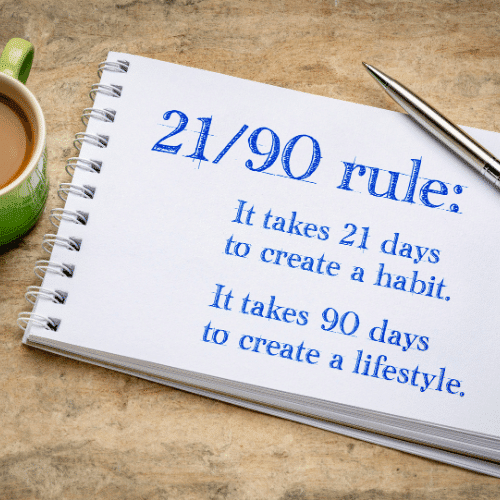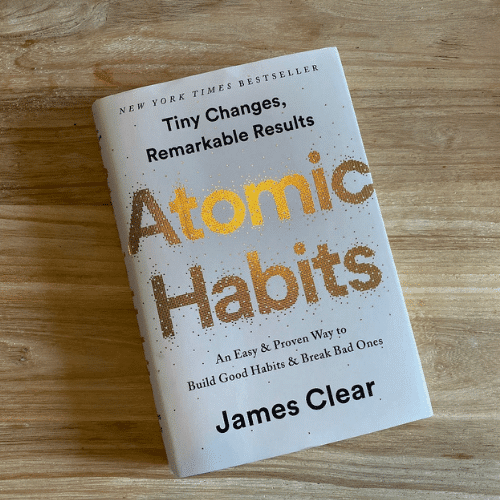Table of Contents
Introduction
“Atomic Habits” is a self-help book written by James Clear that focuses on the idea that small, incremental changes to habits can lead to significant improvements in a person’s life.

Clear argues that successful people are not necessarily more talented or intelligent than others, but rather that they have developed good habits that allow them to consistently take positive actions and make progress.
Clear emphasizes the importance of setting specific, measurable goals and making a plan to achieve them, as well as tracking progress and adjusting the plan as needed.
He also emphasizes the importance of creating a positive environment and surrounding oneself with supportive people who can help to facilitate good habits.
Clear argues that habits can be broken down into four components: the cue, the craving, the response, and the reward. By identifying and understanding these components, a person can change their habits by altering the cue or response, or by finding a different reward.
Clear also discusses the importance of mindset and the role it plays in shaping habits and behavior. He advises readers to focus on progress rather than perfection, and to adopt a growth mindset, which is the belief that abilities can be developed through effort and practice.
One key concept in the book is the “1 percent rule,” which suggests that making small, incremental improvements to a habit can lead to significant progress over time. For example, increasing the number of push-ups you do every day by just one can lead to a significant increase in strength over the course of a year.
Clear emphasizes the importance of establishing a strong foundation of good habits, as they can compound over time and lead to larger improvements and goals. He advises readers to focus on “keystone habits,” which are habits that have a ripple effect and influence other areas of their lives.
The book also discusses the idea of “habit stacking,” which involves attaching a new habit to an existing habit as a trigger. For example, if you already brush your teeth every morning, you could attach a new habit, such as meditating for five minutes, to that existing habit as a trigger.
Clear also advises readers to “invert the habit,” or to make the desired behavior the default option. For example, if you want to start exercising more, you could set up your gym clothes and shoes in a visible location so that it becomes the default option to put them on and go to the gym, rather than having to make a conscious decision to do so every time.
Clear argues that it is important to focus on the process rather than the outcome when trying to develop new habits. He advises readers to celebrate small wins and progress, rather than becoming discouraged if they don’t see immediate results.
The book also discusses the concept of “habit momentum,” which refers to the idea that once a habit is established, it becomes easier to continue. Clear advises readers to take advantage of this momentum by starting small and gradually increasing the difficulty or frequency of the habit over time.
Another important concept in “Atomic Habits” is the idea of “identity-based habits,” which are habits that are aligned with a person’s values and sense of self. Clear argues that habits that are aligned with a person’s identity are more likely to stick and be maintained over the long term.

The book also addresses the issue of breaking bad habits, and provides strategies for doing so, such as creating an “implementation intention” (a specific plan for how to respond to the cue for a bad habit), or finding a “habit replacement” (a positive habit to replace the bad habit with).
In addition to the strategies and concepts outlined in the book, “Atomic Habits” also includes practical tips and exercises to help readers implement the strategies and make lasting changes to their habits.
The book provides a comprehensive guide for developing good habits and breaking bad ones, with the goal of helping readers make small, incremental changes that can lead to significant improvements in their lives.
Overall, “Atomic Habits” provides practical strategies for developing good habits and breaking bad ones, with the goal of helping readers make small, incremental changes that can lead to significant improvements in their lives
The Purpose Of The Book
The purpose of “Atomic Habits” is to provide practical strategies and techniques for developing good habits and breaking bad ones, with the goal of helping readers make small, incremental changes that can lead to significant improvements in their lives.
The book is written by James Clear, and it is based on the idea that small, incremental changes to habits can lead to significant progress over time.
Clear argues that successful people are not necessarily more talented or intelligent than others, but rather that they have developed good habits that allow them to consistently take positive actions and make progress.
He emphasizes the importance of setting specific, measurable goals and making a plan to achieve them, as well as tracking progress and adjusting the plan as needed.
The book also discusses the role of mindset in shaping habits and behavior, and provides strategies for adopting a growth mindset and focusing on progress rather than perfection.
Overall, “Atomic Habits” is designed to help readers identify their habits, set goals, and implement strategies for change, with the goal of helping them make lasting improvements in their lives.
How May This Book Change The Way You Look At Your Own Life?
“Atomic Habits” has the potential to change the way a reader looks at their own life in several ways. Here are a few potential ways that the book could impact a reader:
It could help the reader to understand that small, incremental changes to habits can lead to significant progress over time. This could encourage the reader to focus on the process rather than the outcome, and to celebrate small wins and progress.
The book could help the reader to identify their habits and understand how they are impacting their life. This could allow the reader to see which habits are helpful and which are harmful, and to make changes as needed.
The book could also provide the reader with practical strategies and techniques for developing good habits and breaking bad ones. This could empower the reader to make lasting changes to their habits and improve various areas of their life.
The book could help the reader to adopt a growth mindset and focus on progress rather than perfection. This could change the way the reader approaches challenges and setbacks, and help them to see failures as opportunities to learn and grow.
Overall, “Atomic Habits” has the potential to change the way a reader looks at their own life by providing practical strategies and techniques for developing good habits and making lasting changes to their behavior.
Chapter 1
In Chapter 1 of “Atomic Habits,” James Clear introduces the concept of the “1 percent rule,” which suggests that small, incremental improvements to a habit can lead to significant progress over time.
He uses the example of increasing the number of push-ups a person does every day by just one, which can lead to a significant increase in strength over the course of a year.
Clear also discusses the importance of establishing a strong foundation of good habits, as they can compound over time and lead to larger improvements and goals.

He advises readers to focus on “keystone habits,” which are habits that have a ripple effect and influence other areas of their lives.
In Chapter 1, Clear also introduces the idea of “habit stacking,” which involves attaching a new habit to an existing habit as a trigger.
For example, if you already brush your teeth every morning, you could attach a new habit, such as meditating for five minutes, to that existing habit as a trigger.
Clear also advises readers to “invert the habit,” or to make the desired behavior the default option. For example, if you want to start exercising more, you could set up your gym clothes and shoes in a visible location so that it becomes the default option to put them on and go to the gym, rather than having to make a conscious decision to do so every time.
Overall, Chapter 1 of “Atomic Habits” introduces key concepts and strategies for developing good habits, including the “1 percent rule,” the importance of keystone habits, habit stacking, and inverting the habit.
These strategies are designed to help readers make small, incremental changes to their habits that can lead to significant improvements over time.
Chapter 2
In Chapter 2 of “Atomic Habits,” James Clear discusses the idea that habits can be broken down into four components: the cue, the craving, the response, and the reward.
He argues that by understanding these components, a person can change their habits by altering the cue or response, or by finding a different reward.
Clear advises readers to identify the specific cue that triggers a habit, as well as the craving that drives the habit. He also emphasizes the importance of finding a reward that satisfies the craving and reinforces the habit.
Clear discusses the role of identity in shaping habits, and argues that habits that are aligned with a person’s values and sense of self are more likely to stick and be maintained over the long term.
He advises readers to focus on developing habits that support their long-term goals and values, rather than simply trying to change their behavior in the short term.
In Chapter 2, Clear also introduces the concept of “implementation intentions,” which are specific plans for how to respond to the cue for a habit. He advises readers to create implementation intentions as a way to make it easier to take action and follow through with their desired habits.
Overall, Chapter 2 of “Atomic Habits” discusses the components of habits and provides strategies for changing them, including identifying the cue and craving, finding a satisfying reward, aligning habits with identity, and creating implementation intentions. These strategies are designed to help readers develop good habits and break bad ones.
Chapter 3
In Chapter 3 of “Atomic Habits,” James Clear discusses the role of mindset in shaping habits and behavior. He argues that a person’s mindset plays a significant role in their ability to develop good habits and break bad ones, and that adopting a growth mindset can be a powerful tool for making lasting changes.
A growth mindset is the belief that abilities can be developed through effort and practice, and Clear advises readers to adopt this mindset when trying to develop new habits.
He argues that a growth mindset can help a person to see failures as opportunities to learn and grow, rather than as setbacks or failures.
Clear also discusses the importance of focusing on progress rather than perfection, and advises readers to celebrate small wins and progress rather than becoming discouraged if they don’t see immediate results.
He argues that this approach can help to build momentum and encourage a person to continue working towards their goals.
In Chapter 3, Clear also introduces the concept of “habit momentum,” which refers to the idea that once a habit is established, it becomes easier to continue.

He advises readers to take advantage of this momentum by starting small and gradually increasing the difficulty or frequency of the habit over time.
Overall, Chapter 3 of “Atomic Habits” discusses the role of mindset in shaping habits and behavior, and provides strategies for adopting a growth mindset and focusing on progress rather than perfection.
These strategies are designed to help readers develop good habits and break bad ones.
Chapter 4
In Chapter 4 of “Atomic Habits,” James Clear discusses the role of environment in shaping habits and behavior. He argues that the people, places, and things that a person surrounds themselves with can have a significant impact on their habits and behaviors.
Clear advises readers to create a positive environment that supports their desired habits, and to surround themselves with supportive people who can help to facilitate good habits.
He also advises readers to remove or minimize distractions and triggers for bad habits, and to make it easier to access the tools and resources needed to support good habits.
Clear discusses the importance of making small changes to the environment in order to make it easier to take action and follow through with desired habits.
He advises readers to use “habit stacking” to attach new habits to existing habits as triggers, and to “invert the habit” by making the desired behavior the default option.
In Chapter 4, Clear also introduces the concept of “habit replacement,” which involves finding a positive habit to replace a bad habit with. He advises readers to identify the underlying need or craving that drives a bad habit, and to find a positive habit that satisfies that need in a healthier way.
Overall, Chapter 4 of “Atomic Habits” discusses the role of environment in shaping habits and behavior, and provides strategies for creating a positive environment and using habit stacking and habit replacement to develop good habits and break bad ones.
Chapter 5
In Chapter 5 of “Atomic Habits,” James Clear discusses the importance of accountability in developing good habits and breaking bad ones. He argues that having accountability can help a person to stay motivated and committed to their goals, and can provide a source of support and encouragement when things get tough.
Clear advises readers to find an accountability partner or group, or to use tools such as goal-tracking apps to hold themselves accountable. He also advises readers to set specific, measurable goals and make a plan to achieve them, and to track their progress and adjust the plan as needed.
In Chapter 5, Clear also discusses the importance of celebrating small wins and progress, and advises readers to reward themselves for making progress towards their goals. He argues that this can help to build momentum and encourage a person to continue working towards their goals.
Clear also discusses the importance of building good habits in the long term, and advises readers to focus on the process rather than the outcome. He argues that this can help a person to stay motivated and committed to their goals, even when they face challenges or setbacks.
Overall, Chapter 5 of “Atomic Habits” discusses the importance of accountability in developing good habits and breaking bad ones, and provides strategies for setting goals, tracking progress, and celebrating small wins.
These strategies are designed to help readers make lasting changes to their habits and achieve their goals.
Chapter 6
In Chapter 6 of “Atomic Habits,” James Clear discusses the importance of creating a positive identity in order to develop good habits and break bad ones.
He argues that a person’s identity plays a significant role in their habits and behaviors, and that developing a positive identity can be a powerful tool for making lasting changes.
Clear advises readers to focus on building habits that are aligned with their values and sense of self, and to identify their “habit identity,” or the type of person they want to be.
He argues that habits that are aligned with a person’s identity are more likely to stick and be maintained over the long term.
In Chapter 6, Clear also discusses the importance of creating an “identity-based plan” for developing good habits and breaking bad ones.

He advises readers to identify the habits that are most important to their identity, and to make a plan for how to develop and maintain those habits over time.
Clear also discusses the role of language in shaping identity and habits, and advises readers to be mindful of the words they use to describe themselves and their habits.
He argues that using positive, empowering language can help a person to develop a positive identity and build good habits.
Overall, Chapter 6 of “Atomic Habits” discusses the role of identity in shaping habits and behavior, and provides strategies for developing a positive identity and creating an identity-based plan for developing good habits and breaking bad ones.
These strategies are designed to help readers make lasting changes to their habits and achieve their goals.
Chapter 7
In Chapter 7 of “Atomic Habits,” James Clear discusses the role of social influences in shaping habits and behavior. He argues that the people a person surrounds themselves with can have a significant impact on their habits and behaviors, and that it is important to surround oneself with supportive people who can help to facilitate good habits.
Clear advises readers to identify their “tribe,” or the group of people they spend the most time with, and to make sure that this group is supportive of their goals and habits.
He also advises readers to seek out mentors or role models who can provide guidance and support as they work towards their goals.
In Chapter 7, Clear also discusses the importance of creating a supportive community or “habit family” to help facilitate good habits.
He advises readers to find like-minded people who share similar goals and values, and to work together to support each other’s habits and progress.
Clear also discusses the role of peer pressure in shaping habits and behaviors, and advises readers to be aware of the influence that their peers can have on their habits.
He argues that it is important to surround oneself with supportive, positive people who can help to facilitate good habits, rather than negative or unsupportive people who may discourage progress.
Overall, Chapter 7 of “Atomic Habits” discusses the role of social influences in shaping habits and behavior, and provides strategies for building a supportive network of people who can help to facilitate good habits.
These strategies are designed to help readers make lasting changes to their habits and achieve their goals.
Chapter 8
In Chapter 8 of “Atomic Habits,” James Clear discusses the role of motivation in shaping habits and behavior. He argues that motivation is not a constant, and that it can fluctuate based on a variety of factors.
Clear advises readers to find ways to stay motivated and committed to their goals, even when they face challenges or setbacks. He suggests using techniques such as visualization, positive self-talk, and setting specific, measurable goals as ways to stay motivated.
Clear also discusses the importance of finding a “why” or purpose behind a goal, and advises readers to identify the deeper meaning or significance behind their goals in order to stay motivated and committed to them.
He argues that having a strong sense of purpose can help a person to persevere and overcome challenges or setbacks.
In Chapter 8, Clear also discusses the role of setbacks and failures in shaping habits and behavior, and advises readers to view these experiences as opportunities to learn and grow.
He argues that it is important to focus on the process rather than the outcome, and to celebrate small wins and progress rather than becoming discouraged if things don’t go as planned.
Overall, Chapter 8 of “Atomic Habits” discusses the role of motivation in shaping habits and behavior, and provides strategies for staying motivated and
Chapter 9
In Chapter 9 of “Atomic Habits,” James Clear discusses the role of willpower in shaping habits and behavior. He argues that willpower is a limited resource, and that it can be depleted if a person uses it too frequently or for too long.
Clear advises readers to conserve their willpower by setting up their environment in a way that makes it easier to take action and follow through with desired habits.
He suggests using techniques such as habit stacking, inverting the habit, and creating implementation intentions as ways to conserve willpower.
Clear also discusses the importance of finding ways to replenish willpower, and advises readers to engage in activities that replenish their physical and mental energy. He suggests strategies such as exercising, sleeping, and practicing mindfulness as ways to replenish willpower.
In Chapter 9, Clear also discusses the role of “decision fatigue” in shaping habits and behavior, and advises readers to minimize the number of decisions they have to make in order to conserve willpower
He suggests using techniques such as creating routines and automating decisions as ways to minimize decision fatigue.
Overall, Chapter 9 of “Atomic Habits” discusses the role of willpower in shaping habits and behavior, and provides strategies for conserving and replenishing willpower. These strategies are designed to help readers make lasting changes to their habits and achieve their goals.
Chapter 10
In Chapter 10 of “Atomic Habits,” James Clear discusses the importance of building good habits in the long term. He argues that habits are not formed overnight, and that it takes time and consistency to establish a new habit.
Clear advises readers to be patient and persistent as they work to develop good habits, and to focus on the process rather than the outcome.
He suggests setting specific, measurable goals and tracking progress as ways to stay motivated and committed to building good habits.
Clear also discusses the role of setbacks and failures in shaping habits and behavior, and advises readers to view these experiences as opportunities to learn and grow.
He argues that it is important to focus on the process rather than the outcome, and to celebrate small wins and progress rather than becoming discouraged if things don’t go as planned.
In Chapter 10, Clear also discusses the importance of finding a balance between consistency and flexibility when building good habits.
He advises readers to be consistent in their efforts to develop good habits, but also to be flexible and adaptable if their circumstances change or if their goals shift.
Overall, Chapter 10 of “Atomic Habits” discusses the importance of building good habits in the long term, and provides strategies for staying motivated and committed to building good habits, even when faced with setbacks or failures.
These strategies are designed to help readers make lasting changes to their habits and achieve their goals.
Chapter 11
In Chapter 11 of “Atomic Habits,” James Clear discusses the importance of building good habits in the long term and maintaining them over the course of a person’s life.
He argues that habits are not formed overnight, and that it takes time and consistency to establish a new habit.
Clear advises readers to focus on building habits that are aligned with their values and sense of self, and to identify their “habit identity,” or the type of person they want to be.

He argues that habits that are aligned with a person’s identity are more likely to stick and be maintained over the long term.
In Chapter 11, Clear also discusses the role of motivation in shaping habits and behavior, and advises readers to find ways to stay motivated and committed to their goals, even when they face challenges or setbacks.
He suggests using techniques such as visualization, positive self-talk, and setting specific, measurable goals as ways to stay motivated.
Clear also discusses the importance of finding a “why” or purpose behind a goal, and advises readers to identify the deeper meaning or significance behind their goals in order to stay motivated and committed to them.
He argues that having a strong sense of purpose can help a person to persevere and overcome challenges or setbacks.
Overall, Chapter 11 of “Atomic Habits” discusses the importance of building and maintaining good habits over the long term, and provides strategies for staying motivated and committed to building good habits, even when faced with challenges or setbacks.
These strategies are designed to help readers make lasting changes to their habits and achieve their goals.
Chapter 12
In Chapter 12 of “Atomic Habits,” James Clear discusses the importance of building good habits in the long term and maintaining them over the course of a person’s life.
He argues that habits are not formed overnight, and that it takes time and consistency to establish a new habit.
Clear advises readers to focus on building habits that are aligned with their values and sense of self, and to identify their “habit identity,” or the type of person they want to be.
He argues that habits that are aligned with a person’s identity are more likely to stick and be maintained over the long term.
In Chapter 12, Clear also discusses the role of accountability in shaping habits and behavior, and advises readers to find an accountability partner or group, or to use tools such as goal-tracking apps to hold themselves accountable.
He also advises readers to set specific, measurable goals and make a plan to achieve them, and to track their progress and adjust the plan as needed.
Clear also discusses the importance of building a supportive network of people who can help to facilitate good habits, and advises readers to identify their “tribe,” or the group of people they spend the most time with, and to make sure that this group is supportive of their goals and habits.
He also advises readers to seek out mentors or role models who can provide guidance and support as they work towards their goals.
Overall, Chapter 12 of “Atomic Habits” discusses the importance of building and maintaining good habits over the long term, and provides strategies for holding oneself accountable, setting goals, and building a supportive network of people.
These strategies are designed to help readers make lasting changes to their habits and achieve their goals.
Chapter 13
In Chapter 13 of “Atomic Habits,” James Clear discusses the importance of building good habits in the long term and maintaining them over the course of a person’s life. He argues that habits are not formed overnight, and that it takes time and consistency to establish a new habit.
Clear advises readers to focus on building habits that are aligned with their values and sense of self, and to identify their “habit identity,” or the type of person they want to be.
He argues that habits that are aligned with a person’s identity are more likely to stick and be maintained over the long term.
In Chapter 13, Clear also discusses the role of environment in shaping habits and behavior, and advises readers to create a positive environment that supports their desired habits
. He suggests strategies such as habit stacking, inverting the habit, and creating implementation intentions as ways to make it easier to take action and follow through with desired habits.
Clear also discusses the importance of finding a positive habit to replace a bad habit with, and advises readers to identify the underlying need or craving that drives a bad habit, and to find a positive habit that satisfies that need in a healthier way.
Overall, Chapter 13 of “Atomic Habits” discusses the importance of building and maintaining good habits over the long term, and provides strategies for creating a positive environment and using habit replacement to develop good habits and break bad ones.
These strategies are designed to help readers make lasting changes to their habits and achieve their goals.
Chapter 14
In Chapter 14 of “Atomic Habits,” James Clear discusses the role of small habits in shaping a person’s overall success.
He argues that small habits, or “atomic habits,” can have a significant impact on a person’s overall success and well-being, and that it is important to focus on building good habits in order to achieve long-term success.
Clear advises readers to focus on the “compound effect” of their habits, or the idea that small, consistent actions can lead to significant results over time.
He argues that it is important to focus on building good habits rather than trying to achieve quick fixes or shortcuts to success.
In Chapter 14, Clear also discusses the importance of building habits that are aligned with a person’s values and goals, and advises readers to identify their “habit identity,” or the type of person they want to be.

He argues that habits that are aligned with a person’s identity are more likely to stick and be maintained over the long term.
Clear also discusses the importance of finding a “why” or purpose behind a goal, and advises readers to identify the deeper meaning or significance behind their goals in order to stay motivated and committed to them.
He argues that having a strong sense of purpose can help a person to persevere and overcome challenges or setbacks.
Overall, Chapter 14 of “Atomic Habits” discusses the role of small habits in shaping a person’s overall success, and provides strategies for building good habits that are aligned with a person’s values and goals, and focusing on the compound effect of those habits.
These strategies are designed to help readers make lasting changes to their habits and achieve their goals.
Chapter 15
In Chapter 15 of “Atomic Habits,” James Clear discusses the importance of building good habits in the long term and maintaining them over the course of a person’s life.
He argues that habits are not formed overnight, and that it takes time and consistency to establish a new habit.
Clear advises readers to focus on building habits that are aligned with their values and sense of self, and to identify their “habit identity,” or the type of person they want to be.
He argues that habits that are aligned with a person’s identity are more likely to stick and be maintained over the long term.
In Chapter 15, Clear also discusses the role of motivation in shaping habits and behavior, and advises readers to find ways to stay motivated and committed to their goals, even when they face challenges or setbacks.
He suggests using techniques such as visualization, positive self-talk, and setting specific, measurable goals as ways to stay motivated.
Clear also discusses the importance of finding a “why” or purpose behind a goal, and advises readers to identify the deeper meaning or significance behind their goals in order to stay motivated and committed to them.
He argues that having a strong sense of purpose can help a person to persevere and overcome challenges or setbacks.
Overall, Chapter 15 of “Atomic Habits” discusses the importance of building and maintaining good habits over the long term, and provides strategies for staying motivated and committed to building good habits, even when faced with challenges or setbacks.
These strategies are designed to help readers make lasting changes to their habits and achieve their goals.
Chapter 16
Chapter 16 of “Atomic Habits” by James Clear is titled “The Ultimate Law of Habit Change: Don’t Try to Change Your Habits, Change Your Identity.”
In this chapter, Clear discusses the idea that the most effective way to change your habits is to focus on creating a new identity first.
He argues that when you focus on changing your habits, you are trying to change your behavior, which is difficult and often unsuccessful. However, when you focus on changing your identity, you are changing your beliefs about yourself and your values, which makes it easier to change your behavior.
Clear argues that the key to building good habits and breaking bad ones is to focus on building a new identity as the person who consistently exhibits the desired behavior.
He suggests that you should ask yourself, “Who do I want to be?” rather than “What do I want to do?” and then work to align your habits with that identity.
Clear also discusses the importance of small, incremental changes in building a new identity.
He argues that it is better to focus on making small changes to your behavior on a consistent basis rather than trying to make a big change all at once.
By making small, incremental changes, you can gradually build the evidence and reinforce the identity you want to have.
Overall, Chapter 16 of “Atomic Habits” emphasizes the importance of focusing on building a new identity as the key to changing your habits and achieving success.
By changing your beliefs about yourself and your values, you can more easily change your behavior and build good habits that lead to a better life.
Chapter 17
Chapter 17 of “Atomic Habits” by James Clear is titled “The Identity Change Workout.” In this chapter, Clear provides a structured workout plan for building a new identity and changing your habits.
The workout consists of four steps:
Identify the type of person you want to become. This involves considering your values, goals, and vision for your life and identifying the specific habits and behaviors that align with those values.
Decide the type of person you want to be. This involves committing to a specific identity and making a commitment to consistently exhibit the habits and behaviors that align with that identity.
Prove it to yourself. This involves taking small, incremental actions to build evidence of your new identity. This can involve setting small goals, celebrating small victories, and finding ways to make the habit-building process enjoyable and rewarding.
Repeat the process. This involves consistently reinforcing your new identity and continuing to build evidence of your new habits and behaviors.
Clear argues that the key to building a new identity and changing your habits is to focus on small, incremental actions that build momentum and lead to lasting change. By following this structured workout plan, you can more easily build good habits and break bad ones in order to achieve your goals and improve your life.
Chapter 18
Chapter 18 of “Atomic Habits” by James Clear is titled “The Identity Factor: How Habits Shape Your Future.” In this chapter, Clear discusses the role that identity plays in shaping our habits and our future.
He argues that our habits are shaped by our beliefs about ourselves and our values, and that changing our habits requires us to change our identity.
Clear discusses the idea of “identity-based habits,” which are habits that are aligned with our values and beliefs about ourselves.
He argues that these habits are more likely to stick because they are driven by a sense of purpose and meaning, rather than by external rewards or consequences.
Clear also discusses the idea that our habits create feedback loops that shape our identity. He argues that our habits influence the way we see ourselves and the way others see us, and that this feedback can reinforce or change our identity over time.
Overall, Chapter 18 of “Atomic Habits” highlights the importance of building habits that are aligned with our values and beliefs about ourselves, and the role that identity plays in shaping our habits and our future.
By focusing on building good habits that align with our values, we can more easily achieve our goals and create a better future for ourselves.
Chapter 19
Chapter 19 of “Atomic Habits” by James Clear is titled “The Law of the Few: How to Use the 80/20 Rule to Transform Your Habits.”
In this chapter, Clear discusses the concept of the 80/20 rule, also known as the Pareto Principle, which states that roughly 80% of the effects come from 20% of the causes.
Clear argues that this principle can be applied to habit formation to help you achieve better results with less effort.
Clear discusses the idea that there are a few key habits that have a disproportionate impact on your success and happiness, and that focusing on these habits can lead to significant improvements in your life.
He suggests using the 80/20 rule to identify the few key habits that will have the greatest impact on your life, and focusing on building and improving these habits first.
Clear also discusses the idea that you can use the 80/20 rule to identify and eliminate habits that are not serving you well.
He suggests identifying the habits that are taking up a lot of time and energy, but not providing much value, and finding ways to eliminate or minimize these habits in order to free up time and energy for more valuable habits.
Overall, Chapter 19 of “Atomic Habits” highlights the importance of focusing on the few key habits that will have the greatest impact on your success and happiness, and using the 80/20 rule to identify and eliminate habits that are not serving you well. By focusing on building and improving the right habits, you can achieve better results with less effort.
Chapter 20
Chapter 20 of “Atomic Habits” by James Clear is titled “The Four Rules of Behavior Change.” In this chapter, Clear outlines four rules for building good habits and breaking bad ones:
Make it obvious: Make it easy to start the desired behavior by making it highly visible and accessible.
Make it attractive: Make the desired behavior more appealing by adding rewards or making it more enjoyable.
Make it easy: Make the desired behavior easier to perform by reducing the barriers to entry or making the process more streamlined.
Make it satisfying: Make the desired behavior more rewarding by providing feedback, recognition, or other forms of positive reinforcement.
Clear argues that by following these four rules, you can make it easier to start good habits and break bad ones, and increase your chances of success.
He also discusses the idea that these rules can be used in combination to create a “habit stack,” which is a series of small habits that are stacked together to create a larger, more meaningful change.
Overall, Chapter 20 of “Atomic Habits” outlines a framework for building good habits and breaking bad ones, and emphasizes the importance of making the desired behavior visible, attractive, easy, and satisfying in order to increase your chances of success.
Conclision Part
In the conclusion of “Atomic Habits,” James Clear discusses the idea that small habits can have a big impact on your life. He argues that by focusing on building small, incremental habits that align with your values and beliefs, you can create lasting change and achieve your goals.

Clear also emphasizes the importance of building systems rather than setting goals, and argues that a focus on systems is more effective for achieving long-term success.
He suggests that you should focus on building good habits that support your goals rather than trying to achieve your goals through sheer will or motivation.
Clear also discusses the idea that habits are shaped by our identity, and that changing our habits requires us to change our identity.
He suggests that the key to building good habits and breaking bad ones is to focus on building a new identity as the person who consistently exhibits the desired behavior.
Overall, the conclusion of “Atomic Habits” highlights the importance of building small, incremental habits to achieve lasting change and the role that identity plays in shaping our habits.
It also emphasizes the importance of building systems rather than setting goals, and the need to focus on building good habits that support our goals.
Strategies Of Atomic Habits
Atomic habits are small, incremental changes that can lead to significant improvements over time. They are called “atomic” because they are the smallest unit of change, and they are called “habits” because they are behaviors that are repeated on a regular basis.
Here are a few strategies for building atomic habits:
- Start small: Make the desired behavior easy to do by starting with a small, manageable goal. This can help build momentum and make it easier to stick with the habit.
- Make it obvious: Make it easy to remember to do the desired behavior by placing visual cues in strategic locations. This can include setting an alarm or placing a reminder on your phone or computer.
- Make it attractive: Make the desired behavior more appealing by finding ways to make it fun or rewarding. This can include rewarding yourself with something you enjoy after completing the habit or finding ways to make the habit itself enjoyable.
- Make it easy: Remove any barriers or obstacles that may make it difficult to complete the desired behavior. This can include setting aside dedicated time to complete the habit or simplifying the task itself.
- Make it satisfying: Find ways to make the desired behavior more fulfilling or rewarding. This can include setting small goals or celebrating small victories along the way.
- Set a specific time: Choose a specific time each day or week to complete the desired behavior. This can help to make the habit more consistent and easier to stick with.
- Use a habit tracker: Keep track of your progress with a habit tracker, which can be a physical planner or an app on your phone. Seeing your progress can help to keep you motivated and on track.
- Identify your triggers: Identify the things that trigger you to engage in a certain behavior and try to change those triggers. For example, if you find that you snack mindlessly while watching TV, try to change the trigger by watching TV in a different location or doing a different activity while snacking.
- Make it a routine: Incorporate the desired behavior into your daily routine by doing it at the same time each day. This can help to make it feel more automatic and easier to stick with
- Get accountability: Seek out someone to hold you accountable to your habit-building goals. This can be a friend, family member, or coach who can help to keep you on track and motivate you to keep going.
- Find a role model: Look for someone who embodies the habits you want to build and use them as a role model. This can help to provide inspiration and motivation as you work to build your own habits.
- Set a reminder: Use a reminder to help you remember to complete your desired behavior. This can be a physical reminder, such as a sticky note, or an electronic reminder, such as an alarm on your phone.
- Change your environment: Make changes to your physical environment to make it easier to engage in the desired behavior. For example, if you want to start exercising more, make sure you have the necessary equipment and a designated space for workouts.
- Seek support: Surround yourself with people who support and encourage your habit-building efforts. This can include friends, family, or a support group of like-minded individuals.
- Celebrate your victories: Take time to celebrate your successes and progress as you work to build your atomic habits. This can help to keep you motivated and on track.
- Focus on one habit at a time: Instead of trying to change multiple habits at once, focus on building one habit at a time. This can help to make the process more manageable and increase your chances of success.
- Use visualization: Visualize yourself successfully completing the desired behavior, which can help to increase your motivation and confidence.
- Practice mindfulness: Practice mindfulness as you work to build your atomic habits. This can help you to be more aware of your thoughts, feelings, and behaviors, which can make it easier to identify and overcome any challenges or obstacles that may arise.
- Find a accountability partner: Find someone who can hold you accountable to your habit-building goals. This can be a friend, family member, or coach who can help to keep you on track and motivated.
- Reward yourself: Find ways to reward yourself for successfully completing the desired behavior. This can be a small treat, a fun activity, or a simple acknowledgement of your progress.
Remember to be patient and consistent as you work to build your atomic habits. It can take time for habits to become ingrained, so don’t get discouraged if you don’t see immediate results. Keep working at it and you will see progress over time.
Book Recommebdations Similar To Atomik Habits:
There are many books that are similar to “Atomic Habits” by James Clear and focus on the importance of building good habits to achieve success and improve your life.
Here are a few book recommendations:
- “The Power of Habit” by Charles Duhigg: This book explores the science of habits and how they shape our lives, and offers strategies for building and changing habits to achieve your goals.
- “Better Than Before: What I Learned About Making and Breaking Habits – to Sleep More, Quit Sugar, Procrastinate Less, and Generally Build a Happier Life” by Gretchen Rubin: This book discusses the different habit-forming strategies that work for different people and offers practical tips for building and maintaining good habits.
- “The Compound Effect: Jumpstart Your Income, Your Life, Your Success” by Darren Hardy: This book discusses the idea that small, incremental changes can lead to significant improvements over time, and offers strategies for building good habits to achieve your goals.
- “The Miracle Morning: The Not-So-Obvious Secret Guaranteed to Transform Your Life (Before 8AM)” by Hal Elrod: This book discusses the importance of building good morning habits and offers a structured routine to help you start your day off on the right foot.
- “Habit Stacking: 97 Small Life Changes That Take Five Minutes or Less” by S.J. Scott: This book offers a collection of simple, actionable habits that can be easily incorporated into your daily routine and stacked together to create meaningful change.
- “The One Thing: The Surprising Simple Truth Behind Extraordinary Results” by Gary Keller and Jay Papasan: This book discusses the importance of focusing on the one thing that is most important to you and building habits around that goal to achieve success.
These books offer a variety of approaches and strategies for building good habits and can provide valuable insights and inspiration as you work to improve your life and achieve your goals.
Favorite Atomic Habits Quotes:
Here are a few of my favorite quotes from “Atomic Habits” by James Clear:
- “Habits are the compound interest of self-improvement.”
- “You do not rise to the level of your goals. You fall to the level of your systems.”
- “The most effective way to change your habits is to focus on creating a new identity first.”
- “Small habits make a big difference over time.”
- “The first law of behavior change is to make it easy.”
- “You should be far more concerned with your current trajectory than with your current results.”
- “Success is the product of daily habits – not once-in-a-lifetime transformations.”
- “The goal is not to create a new habit. The goal is to create a new identity.”
- “The most practical way to create a new habit is to start with a small, easy behavior and gradually increase the difficulty.”
- “Habits are the invisible architecture of our lives. It is the foundational structure that supports everything we do.”
- These quotes highlight the importance of building good habits in order to achieve success and improve your life. They also emphasize the idea that small, incremental changes can lead to significant improvements over time.
- “The more you ritualize your habits, the more automatic they become.”
- “Habits are the compound interest of self-improvement. The same way that money multiplies through compound interest, the effects of your habits multiply as you repeat them. They seem to make little difference on any given day and yet the impact they deliver over the months and years can be enormous. It is only when looking back two, five, or perhaps ten years later that the value of good habits and the cost of bad ones becomes strikingly apparent.”
- “Every action you take is a vote for the type of person you want to become. No single instance will transform your beliefs, but as the votes build up, so does the evidence of your identity.”
- “Good habits are the key to all success. Bad habits are the unlocked door to failure.”
- “The quality of our lives is a reflection of the quality of our habits.”
- “A goal is a specific objective that you either achieve or fail to achieve. A system is a set of habits that you follow on a regular basis. If you want to get better at something, you must either change your goals or change your system.”
- “The purpose of setting goals is to win the game. The purpose of building systems is to continue playing the game.”
- “The more you do something, the more you reinforce the identity associated with it.”
- “Habits are the backbone of our lives. They shape our daily routines and ultimately determine the person we become.”
- “Habits are the small decisions you make and actions you perform every day. Regardless of how successful you are, you are where you are today because of the habits you have formed.”
These quotes highlight the importance of building good habits and the role they play in shaping our lives and identities. They also emphasize the idea that habits can have a cumulative effect and that it is important to focus on building a consistent system rather than just setting goals.
Questions For Dialogue:
- In your opinion, what is this book about?
- If you’ve read this book, how has it altered your perspective on your own life?
- Which identity do you seek or already possess (who would you desire to be?) Why?
- What do you think you’ve discovered about human nature?
- Please share how your outlook on life has shifted as a result of reading this book.
Habits:
- How have you found it most challenging to establish new routines? Where can you even begin to get solace from this?
- Can you describe the most challenging aspect of breaking a bad habit? In what ways might you expect to overcome this? It could be something you’ve done since you were a kid or a young adult.
- What strategies for incremental progress (1% wins) or habits do you plan to adopt or already practice to help you realize your full potential and realize your life’s ambitions?
- What keeps you going when you want to give up on your routine (or your objectives)?
- Do you need help fixing something? Exactly what are they? In what way may your routine assist you deal with this issue?
- In what ways have you used or planned to use these tactics? Can you elaborate on the ways in which implementing these tactics will benefit your personal or professional life?
Philosophy:
- No matter how much the world or technology advances, the human brain remains essentially unchanged. And what do you think about this?
- In what ways do you think the ‘cultural norms’ where you come from support or undermine efforts to form healthy routines? Without without realizing it, you unwittingly adhere to cultural norms.
- How do people usually try to impress others?
- When do you think it’s acceptable to act like your heroes?
Personal:
- When it comes to progress, what environmental factors have been holding you back? If you have already dealt with this problem, please explain how.
- Explain how you fared in a situation where you had to make a quick decision.
- What are your thoughts on keeping a journal, and do you keep one?
- How can I expedite the payoff from an activity with a long lag time, like writing a book or working out?
- Which of your healthy routines do you really relish?
Motivation:
- Do you utilize any specific habit trackers? Just fill us in on the details. The professional and personal spheres of existence.
- Which metrics do you attempt to stay away from?
- In what ways do your natural skills and interests complement one another?
- What are some good-for-you activities that you no longer enjoy doing? What can you do to fix this?
- To what extent do you practice in order to hone your abilities?
Buy this book @ Amazon: “Atomic Habits”
Read more book summaries: “If a human has no direction, every wind is a fresh breeze” ― lenfantvivant
“Thought is only an abstraction representing a fraction of what is.” ― Lenfantvivant

